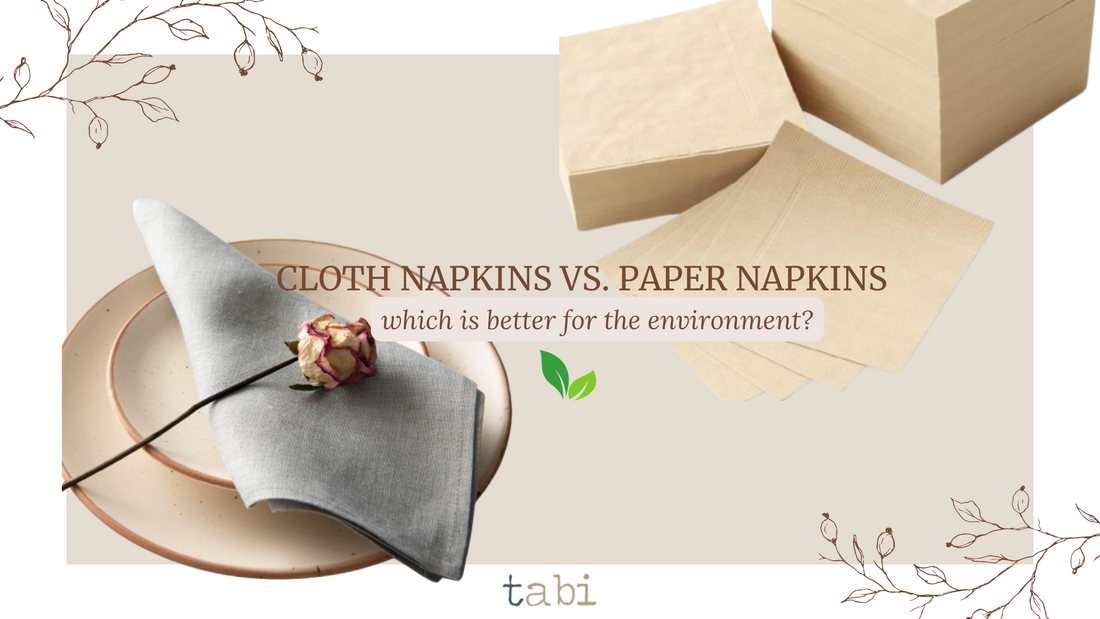
Cloth Napkins vs. Paper Napkins: Which is Better for the Environment?
In an era where environmental issues dominate our discussions, even minor decisions can significantly influence our planet's health. A common dilemma many encounters is the choice between cloth and paper napkins. Each alternative presents its advantages and disadvantages, but which one is more beneficial for the environment? This analysis will delve into the ecological effects of both cloth and paper napkins to identify the more sustainable option.
Environmental impact of paper napkin
The environmental impact of paper napkin production is significant, primarily due to the extensive resources required for their manufacture. As these napkins are predominantly composed of wood pulp, their production leads to the deforestation of approximately 17 trees for every ton produced. Furthermore, this industry is responsible for emitting about 7.5 pounds of greenhouse gasses for each ton produced.
Comparison with Cloth Napkin Production
Cloth napkins present a significantly lower ecological impact compared to their paper counterparts. Their durability allows for repeated use, which minimizes the need for constant production and disposal, ultimately leading to a reduced carbon footprint. By opting for cloth napkins, consumers can help decrease the demand for resources and mitigate the negative effects associated with paper production, promoting a more sustainable approach to dining.
The Significance of Sustainable Sourcing in Napkin Production
The significance of sustainable sourcing in napkin production cannot be overstated in today's environmentally conscious world. By opting for sustainable sourcing practices, napkin manufacturers can significantly reduce their carbon footprint, preserve natural resources, and support local communities. Sustainable sourcing ensures that raw materials are obtained in a responsible manner, without causing harm to the environment or depleting precious resources. In addition, sustainable sourcing fosters transparency and accountability in the supply chain, ensuring ethical practices from sourcing to production. Embracing sustainable sourcing in napkin production is not just a trend but a crucial step towards a more sustainable and ethical future for the industry.
Usage and Reusability: Single-Use vs. Multi-Use
There are some crucial factors to take into account while deciding between paper and cloth napkins, like recycling and reusability. Paper napkins are only good for one usage before having to be thrown away. Nevertheless, you can add them to your compost bin because they decompose naturally. There's a catch, though. Your paper serviette should not be added to the compost if it is soiled with fats, cooking oil or animal proteins. This is due to the fact that these materials are difficult to decompose and will just rot in the pile. Keep paper towels away from the compost pile if you used them to wipe soapy water off your countertop because detergent disrupts the microbes that break down compost.
Since they are reusable, cloth napkins are a greener option than paper towels. When a cloth serviette gets dirty, just wash it and use it again for years of use.
Cloth napkins can be taken to a recycling company, even when you are unable to recycle them yourself. You can use your cloth serviette as a rag if it gets a stain on it that you can't seem to get off. In general, take into account the napkins' capacity for reuse and recycling while deciding between paper and cloth napkins. Since they can be recycled after they are no longer needed, cloth napkins are a more environmentally friendly option.
Why Choose Organic Cloth Napkins: Beyond Regular Napkins
Organic cotton serves as an attractive alternative to conventional cotton in sustainable practices. Unlike traditional cotton farming, organic cotton cultivation avoids the use of chemical pesticides and fertilizers, resulting in lower greenhouse gas emissions. These characteristics position organic cotton as a preferred option for individuals seeking to adopt more environmentally friendly habits in their everyday lives.
Another commendable sustainable fabric is linen, which is produced from the flax plant and requires significantly fewer resources and water compared to cotton. Often cultivated without synthetic chemicals, linen enhances its sustainability profile. Its durability and long lifespan further bolster its environmental benefits, making it a popular choice among those committed to eco-conscious living.
Conclusion
When we switch to cloth towels from paper towels, just think of all the trees that are spared. They are the ideal option for daily use because they are reasonably priced and environmentally friendly.
FAQs
1. What impact does paper napkin production make to the environment?
The process of making paper napkins requires extensive tree-cutting, which contributes to deforestation. Its production method uses a lot of water and eventually produces emissions of greenhouse gasses.
2. How do cloth napkins compare with paper napkins concerning reuse?
When compared to single-use paper napkins, several multi-use cloth napkins are made to be used repeatedly, which significantly reduces waste output. Cloth napkins can be used for more things after meals.
3. Why use organic cloth napkins?
Switching to organic cloth napkins is a sustainable choice that benefits both your health and the environment. Unlike disposable paper napkins, organic cloth napkins are reusable, reducing waste and helping to conserve natural resources. Organic cloth napkins are free from harmful chemicals and pesticides, making them safer for you and your family.
4. Are Cloth napkins a long-run bargain?
Cloth napkins are a sustainable and economical choice in the long run compared to disposable paper napkins. While they may require a higher upfront investment, cloth napkins are durable and can be used repeatedly, reducing the need for purchasing disposable napkins frequently.
5. Could I change the way I usually use napkins to promote sustainability?
Use cloth napkins instead of paper and think of many more sustainable practices that we can adopt. Observe your consumption patterns and engage in practices that ensure the reuse and recycling of things in the home.
